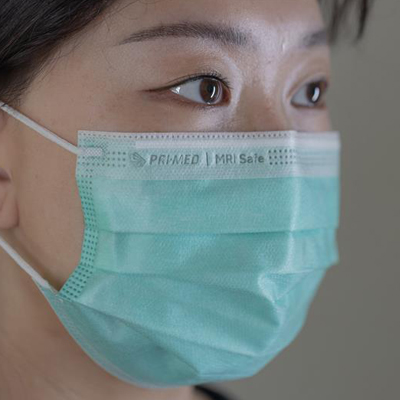Optimizing Gown Protection

Proper Donning and Doffing Procedures
As one of the most commonly used pieces of personal protective equipment (PPE) to minimize exposure to pathogens for healthcare workers, single-use gowns are an affordable, effective part of controlling infectious disease spread in healthcare facilities of any size.
However, proper donning and doffing is critical to reducing infection risk and ensuring the well-being of workers and patients alike.
In this guide, we provide best practices to avoid the risk of contamination or infection when using single-use gowns.
Preparing to Don Your Single-Use Gown
Regardless of the design, you’ll start the donning process similarly.
1. Take hold of the gown from the neck area.

2. Allow the rest of the gown to unfold.
If the gown does not naturally fall down and open, you can use a quick downward snapping motion to help fully open the gown and prepare for donning.

Donning Your Single-Use Overhead Open Back Thumbloop Gown
1. Slide your arms into the sleeves and hands into the thumbloop cuffs.

2. Pull the gown over your head.

3. Tie the waist tie at the back of the gown.

Doffing Your Single-Use Overhead Open Back Thumbloop Gown
1. Pull the shoulders of the gown to break the neck closure.

2. Pull again at the waist to break the ties.

3. Roll the gown down the body inside out into a ball with your medical gloves to ensure fluids and contaminants are contained.
All areas except cuffs and hems are considered critical zones of protection for isolation gowns. Avoid critical zones when balling your gown for disposal.

4. Discard gown in an appropriate receptacle.
Some users may require special disposal depending on your local facility’s rules and applicable regulations.

Watch this video to see donning and doffing in action:
Donning Your Single-Use Tie Neck Closure Full Back Gown
1. Pull sleeves over arms and hands through thumbloop cuffs.

2. Tie the gown at the back of the neck.

3. Pull gown closed at the back to protect your body.

4. Tie the waist tie at the back of the gown.

Doffing Your Single-Use Tie Neck Closure Full Back Gown
1. Untie the neck tie.

2. Grasping the gown at the sides of the waist, pull the gown away from the body to break the waist tie.

3. Peel the gown away from the neck and shoulders.

4. Roll the gown down the body inside out into a bundle to ensure any fluids and contaminants are contained.

5. Discard gown in an appropriate receptacle.
Some users may require special disposal depending on your local facility’s rules and applicable regulations.

Watch this video to see donning and doffing in action:
Common Questions About Gown Usage and Protection
1. Are all gowns the same?
Definitely not. Different gown types are designed for specific uses and offer varying levels of coverage and protection. Combine this with different material types and you’ll find gowns all meet different standards for fluid resistance, leak protection, filtering capacity, or resistance to tears and snags.
Depending on the level of protection provided, gowns may be used for anything from janitorial work and being worn by visitors to protecting healthcare providers as they interact with patients. This flexibility allows gowns to be tailored to the needs of virtually any healthcare environment or scenario.
2. How Do Single-Use Gowns and Reusable Gowns Compare?
Typically made from woven fabrics like cotton or other synthetic fibres, reusable gowns are disinfected and cleaned before re-wearing.
Depending on the specific type of gown and its protection level (e.g. surgical versus isolation versus patient etc.) it may have a limited number of wearing and cleaning cycles before it must be disposed of. Linen gowns are a great example and are still very popular in European healthcare systems.
Single-use gowns are often made of nonwoven polymers and/or films and are disposed of after use.
This makes their use and lifecycle significantly more straightforward from a facilities management perspective by avoiding the need to maintain or contract potentially costly laundering services.
3. Is gown fit important?
Proper fit is essential to maximize the protective benefits of a gown.
Using gowns which are too small can reduce coverage and inhibit movement. This not only increases infection risk but can reduce mobility and performance. Small gowns are also at greater risk for ripping and tears.
If a gown is too large, it could create a tripping hazard or create excessive openings around the neck and other critical coverage areas. Also, gathered material can create obstructions when performing actions.
4. When should I replace or dispose of a medical gown?
You should always follow regulations and recommendations for PPE disposal based upon the environments and scenarios in which they are used.
However, there are several situations in which most PPE — including medical gowns — should be replaced or disposed of, including:
- If any fluid has soiled the gown
- If an object has penetrated the material of the gown
- If there is any abrasion on the gown
5. What benefits do thumbloop gowns provide?
Thumbloop gowns are an excellent way to ensure a complete seal between the gloves and gown sleeves. This not only helps to reduce the risk of exposure or infection, but also can reduce the movement of the sleeves while performing tasks.
6. What level of protection do PRIMED medical gowns offer?
Our selection of tie neck isolation gowns, tape tab closure isolation gowns, and full back and open back overhead thumbloop gowns are available in a variety of protection levels and standards ranging from unrated spunbond models to AAMI 3 rated isolation gowns.
7. How can I compare protection levels between gown designs?
Various AAMI ratings refer to how gowns perform during AAMI PB70:2012 testing — the global standard for protection criteria of isolation gowns.
The ratings, ranging from Level 1 to Level 4, provide details as to the liquid barrier performance and classification of protective apparel and drapes intended for use in health care facilities.

Key Takeaways
- As with all PPE, proper donning and doffing is critical to optimizing protective benefits
- Always match gown ratings to the intended usage
- Always inspect gowns before donning to ensure proper protection
- When doffing, avoid touching critical zones to avoid contaminant exposure
- Follow all disposal requirements based upon your gown usage
With a full range of medical gowns, masks, gloves, headwear, shoe coverings, and more, PRIMED is a leading provider of PPE throughout North America. Our gown selection covers a spectrum of protection levels — from unrated to AAMI Level 4 rated options — to ensure comfortable, high-quality protection for healthcare professionals serving on the front lines of modern healthcare. Contact us today for more information on options which meet your needs.
Related Resources
PRIMED MRI Safe Mask: Safe by Design for Purpose-Built Protection
PRIMED's ASTM Level 3 MRI Safe Masks offer a high-quality, purpose-built solution that merges MRI compatibility with premium protection.

From the Sterile Core to the Decision Table: Elevating the Voice of MDR Professionals
MDR professionals don’t just process products, they influence how they are designed, selected, and standardized.
%20-%20Sterlization%20Wrap%20Display%20(1).jpg)
Protecting with Purpose: The Supply Chain Behind the Mission
PRIMED, resilient through the pandemic, has evolved our supply chain - now stronger, smarter, and ready to meet future challenges with agility and confidence.


